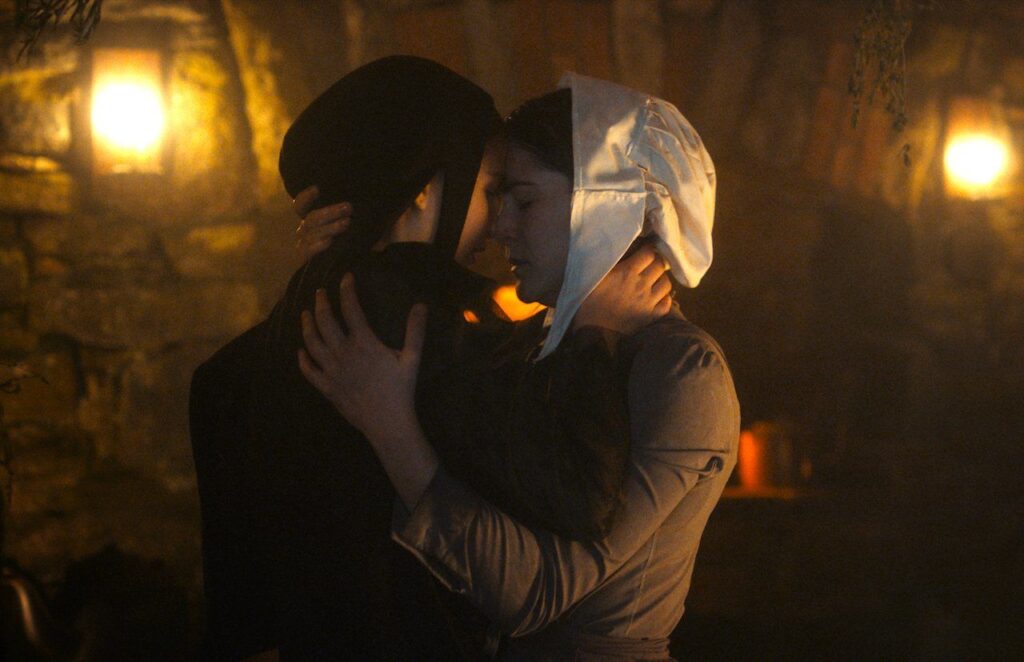
Edoardo Vitaletti’s The Last Thing Mary Saw is one of the more impressive horror films of recent years on a compositional level. Set in lonely misbegotten patch of land in New England in the 1840s it seems as if all the colour has been drained out of the world during daylight, and the more recent trends of muted colour grading have the rare positive effect of making sickly an otherwise pastoral space. However, the real beauty is when the sun goes down, and housemaid Eleanor (Isabelle Fuhrman) runs off with young Mary (Stefanie Scott), and they make sapphic fun with one another, lit gracefully with a barrage of candles, lanterns, and natural fire, which gives both actresses a glowing amber hue. This old New England family home is separated from the rest of the world, and travellers like Rory Kulkin’s Intruder, who has no name, brings with him poisons for a barter. Knowing the time and place where this story resides should indicate to all that the delight to be had in Eleanor and Mary’s tryst is the kind that will be punished by a religious dogma, and true enough Vitaletti begins his movie with a quote asserting God’s ever watchful eye. But they risk it all anyway, and find that those lanterns forging a path of seduction answered cannot illuminate the barren space of a newly plucked eye.
The proposition of settlement in the Americas was always founded on foolish notions of building a utopia of like-minded individuals who wished to enforce their social, and religious practices, on all born into the sect. In movies this usually manifests itself through the conflict of freeing oneself from patriarchal notions of sexism, whose endpoint is a witch burned at the stake. The Last Thing Mary Saw operates under these modes of communication, but with a twist of queer representation that isn’t inserted for titillation, but for thematic resonance. While Mary has more than a few things in common with witch-burning fables, such as the inquisition of religious leaders, and rituals meant to punish those found in league with Satan, it is more rightly considered as a portrait of conversion therapy. Eleanor and Mary are not immediately disposed of when they are found wrapped around one another in a barn. Their elders are good New Englanders who try to set them right by a series of punishments, and tortures, meant to rid the body of that spark that comes with sexual attraction. The most vicious of these, and it is leaned into with close-ups, are prayer sessions where the bended knees of these sinners are pressed into bricks. The effect of this is a strongly composed image in its own right of religion and punishment made sensual by the bowing and offering of the body to the slab. It is never revealed which religion Mary’s family adheres to, but it is some Christian gumbo of Catholicism and Protestantism with a dash of witchcraft from the eldest matriarch (Judith Roberts).
A utopia is only ever achievable in a personal lens of self-fulfillment and the early settlements of America were turned into a graveyard for all those who believed different. Vitaletti’s film evokes comparisons to M. Night Shyamalan’s The Village (2004) with its red oaks, burning oranges and brambled tree limbs decorating the background, but it also does so in thematic terms of romanticism. Mary isn’t much of a horror movie, but as a desperate story of queer love made to snap back in the pursuit of survival it is more than adequate. When the eldest matriarch dies suddenly there is a long stretch where the film is without dialogue due to a belief in the family that in order to grieve one must be silent for twenty-four hours. It is a bold choice on the part of the director, who seems to believe that a movie cannot be worth all that much if it cannot communicate itself visually. The funeral section is impressive with angular, Bergman-esque blocking of bodies draped in black robes and lace. It is here when the film becomes something else entirely and a murder plot is envisioned where Mary and Eleanor may have to kill them all for their love to survive, and communicate through eye contact and hidden languages. This sends things into a territory of conservative realism against queer people that is still very much alive today. Fuhrman is particularly great in this stretch, with complex, ruminative body language of someone broken, but refuses to be for much longer. Fuhrman came into horror cinema with a lightning bolt in Jaume Collet Serra’s Orphan (2009), one of the best performances in the genre in the last fifteen years, and this is another fine point in her resume. Horror movies have been plagued as of late with a thematic heaviness that overrides concerns of genuine craft, but The Last Thing Mary Saw is an exception. This is a movie where lighting, movement, and visual language are the first concern and everything else is informed by those choices. It challenges itself to find a new way of interpreting a fable of sexist condemnation, and does so visually, in hidden lights under the cover of night, close-ups of chalked knees in anguish, and the sensuality of thin, clasping fingers clutching an identical hand for release and for pleasure.
Be First to Comment